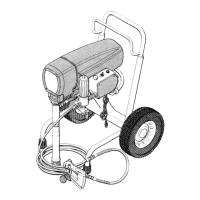WARNING
HIGH PRESSURE SPRAY CAN CAUSE SERIOUS INJURY.
FOR PROFESSIONAL USE ONLY. OBSERVE ALL WARNINGS.
Read and understand all instruction manuals before opera:ing equipment.
This equipment generates very high fluid pressure. Spray from
the gun, leaks or ruptured components can inject fluid
through your skin and into your body and cause extremely
serious bodily injury, including the need for amputation. Also,
fluid injected or splashed into the eyes can cause serious
damage.
NEVER point the spray gun at anyone or at any part of the
body. NEVER put hand or fingers over the spray tip. NEVER
try to “blow back” paint; this is NOT an air spray system.
Spray Gun Safety Devices
Be sure all gun safety devices are operating properly before
each use. Do not remove or modify any part of the gun; this
can cause a malfunction and result in serious bodily injury.
Safety Latch
Whenever you stop spraying, even for a moment, always set
the gun safety latch in the closed or “safe” position, making
the gun inoperative. Failure to set the safety latch can result in
accidental triggering of the gun.
Diffuser
ALWAYS have the tip guard in place on the spray gun when
spraying.
The gun diffuser breaks up spray and reduces the risk of injec-
tion when the tip is not installed. Check diffuser operation
ALWAYS follow the
Pressure Relief Procedure,
below,
before cleaning or removing the spray tip or servicing any
system equipment.
NEVER try to stop or deflect leaks with your hand or body,
Be sure equipment safety devices are operating properly
before each use.
lI)rledifiaJ Treatment
any urd appears to penetrate your skin, get
EMERGENCY MEDICAL CARE AT ONCE.
DO NOT TREeT/IS A SIMPLS C&Jzeatment
Tell the doctor exactly w at lurd was rnjecte .
instructions, have your doctor call the
NATIONAL POISON CENTER NETWORK
(4121681-6669
regularly. Follow the
Pressure Relief Procedure,
below,
then remove the spray tip. Aim the gun into a metal pail,
holding the gun firmly to the pail. Using the lowest possible
pressure, trigger the gun. If the fluid emitted is not diffused in-
to an irregular stream, replace the diffuser immediately.
Tip Guard
ALWAYS have the tip guard in place on the spray gun while
spraying. The tip guard alerts you to the injection hazard and
helps prevent accidentally placing your fingers or any part of
your body close to the spray tip.
Spray Tip Safety
Use extreme caution when cleaning or changing spray tips. If
the spray tip clogs while spraying, engage the gun safety latch
immediately. ALWAYS follow the
Pressure Relief Pro-
cedure
and then remove the spray tip to clean it.
NEVER wipe off build-up around the spray tip until pressure is
fully relieved and the gun safety latch is engaged.
Pressure Relief Procedure
To reduce the risk of serious bodily injury, including injection, splashing in the eyes, injury from splashing fluid or solvent in the
eyes or on the skin, moving parts or electric shock, always follow this procedure whenever you shut off the sprayer, when
checking or servicing any part of the spray system, when installing, cleaning or changing spray tips, and whenever you stop
spraying. (11 Engage the gun safety latch. (2) Turn the ON/OFF switch to OFF. (3) Unplug the power supply cord. (41 Disengage
the gun safety latch. (5) Hold a metal part of the gun firmly to the side of a grounded metal pail, and trigger the gun to relieve
pressure. (61 Engage the gun safety latch. (7) Open the drain valve, having a container ready to catch the drainage. (8) Leave the
drain valve open until you are ready to spray again.
If YOU suspect that the spray tip or hose is completely clogged, or that pressure has nor been fully relieved after following the
steps above, VERY SLOWLY loosen the tip guard retaining nut or hose end coupling and relieve pressure gradually, then loosen
completely. Now clear the tip or hose.
UNPLUG CORD
DISENGAGE SAFETY
AND TRIGGER GUN;
ENGAGE SAFETY AGAIN
ENGAGE SAFETY TURN SWITCH TO OFF
OPEN DRAIN VALVE
2
307-643

